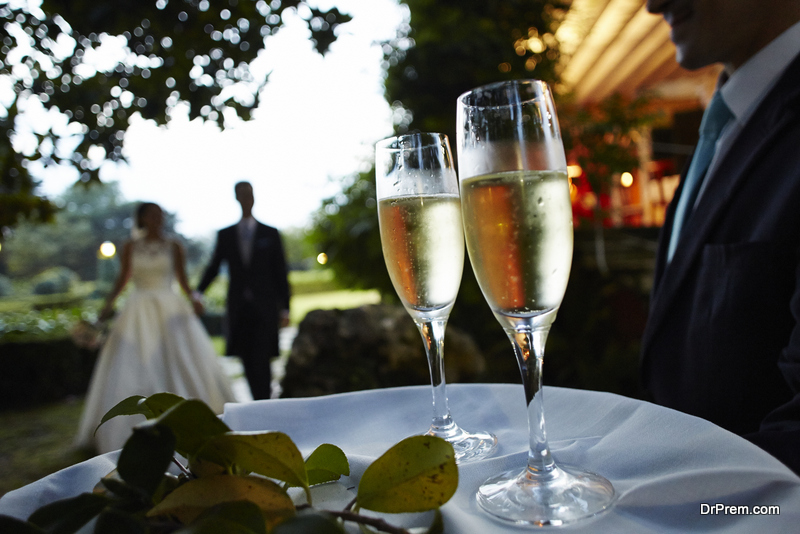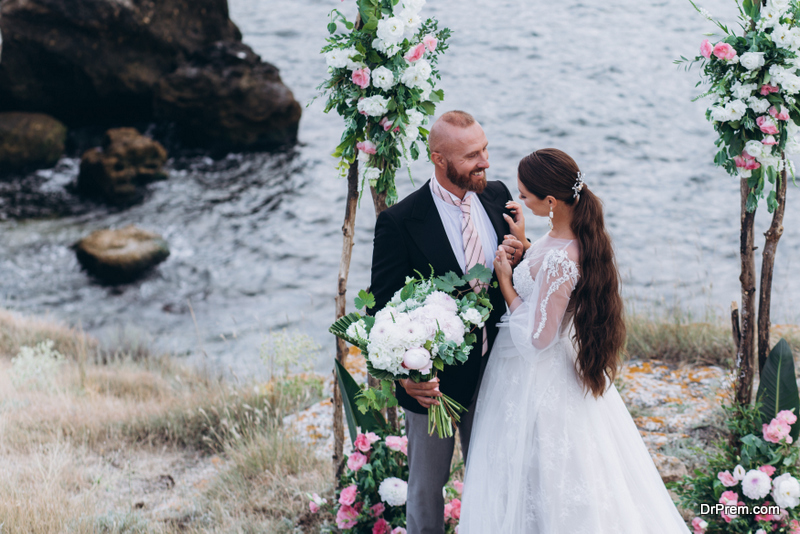It’s no surprise that sustainability and eco-friendliness are gaining traction, and more consumers than ever are worried about their personal impact on the planet. A massive 73% of global consumers have admitted to thinking about changing their consumption habits in order to reduce their overall impact on the environment, and this isn’t only extending to their day-to-day living. According to Pinterest, searches for ‘sustainable wedding ideas’ increased by a huge 181% between 2018 and 2019.
But when it comes to planning an eco-friendly wedding, there is a huge range of factors to be considered. Things like venue location, catering options, invitations, party favors, and even the outfits you wear can all be eco-friendly—you just need to know where to look.
1. Choose a local venue
 You can drastically reduce your carbon footprint by choosing a venue that’s conveniently located for both you and your guests. According to the Good Beginning, transportation is the causes the largest proportion of the carbon footprint of the average American wedding, with 43 out of 56.15 tonnes. A local venue will save you and your guests from having to travel very far, and could reduce the amount of transportation used for your wedding. Even if you have some family or friends who will need to fly from overseas to attend your wedding, minimizing other guests’ travel can help to balance emissions and keep your average carbon footprint low.
You can drastically reduce your carbon footprint by choosing a venue that’s conveniently located for both you and your guests. According to the Good Beginning, transportation is the causes the largest proportion of the carbon footprint of the average American wedding, with 43 out of 56.15 tonnes. A local venue will save you and your guests from having to travel very far, and could reduce the amount of transportation used for your wedding. Even if you have some family or friends who will need to fly from overseas to attend your wedding, minimizing other guests’ travel can help to balance emissions and keep your average carbon footprint low.
You can even look at how sustainable your choice of venue is. For example, choosing a permanent building rather than a marquee is much eco-friendlier, as it reduces transportation and construction emissions. The right venue may also have its own sustainable practices, such as recycling facilities, low-emission lights, and even local suppliers, so it’s worth checking with the owners.
2. Consider eco-friendly flowers
Making your wedding sustainable doesn’t mean you can’t have the accessories you want, and the flowers you choose are a big part of that. One of the best ways to reduce the environmental impact of your wedding bouquet is by taking the time to pick seasonal and local blooms. This minimizes the need to grow your own flowers in greenhouses, or even have them shipped internationally. Speak to your florist about sourcing local blooms, or find a supplier that specializes in creating sustainable arrangements for weddings. Blooming Haus, for example, relies on foraging local flowers, and will even plant a tree for every client they work with, in order to offset any carbon emissions.
For centerpieces, consider asking your florist to avoid the use of floral foam, as this falls into the same bracket as single-use plastic, breaking down into microplastic particles and releasing toxins into the environment. Opt for vases or potted plants instead, which are not only more sustainable, but can double up as keepsakes for guests after the big day.
3. Hire outfits or shop vintage items
 Depending on how many events you plan for your wedding—or whether you want a costume change—you will need multiple outfits. You’ll also need to consider what your bridesmaids, flower girls, groomsmen, and others in your wedding party will be wearing. Buying brand new outfits may seem like a waste of money and resources, especially if you won’t be wearing them again after the reception. Instead, you can opt to hire your outfits for the day, which is considered common practice for suits.
Depending on how many events you plan for your wedding—or whether you want a costume change—you will need multiple outfits. You’ll also need to consider what your bridesmaids, flower girls, groomsmen, and others in your wedding party will be wearing. Buying brand new outfits may seem like a waste of money and resources, especially if you won’t be wearing them again after the reception. Instead, you can opt to hire your outfits for the day, which is considered common practice for suits.
If you want something to keep, however, consider shopping from retailers who specialize in vintage or pre-loved clothing. Abigail’s Vintage Bridal, for example, sources and restores vintage wedding dresses, from Edwardian gowns to 50s dresses. The team also offer alterations for any items you choose, allowing you to give new life to a unique style without contributing to the ecologically unsound fast fashion industry.
4. Curate a sustainable menu
One of the easiest ways to reduce your environmental impact is by choosing the right food. Locally-grown, seasonal, and organic food isn’t difficult to come by, and it should be easy enough to find a caterer that can accommodate your requests. If the venue you choose has its own in-house catering company, find ways to work with their suppliers. For example, picking the right menu means that you can avoid having specific ingredients flown in out-of-season.
Keep your pollutants as low as possible by switching to a vegetarian or vegan menu, which helps to reduce emissions of greenhouse gases, global acidification, as well as land and water use. It’s been revealed that emissions from meat production are worse for the environment than those from energy usage, so picking a vegetarian menu can further reduce your wedding’s carbon footprint.
5. Opt for multi-use, biodegradable decorations
 Many decorations involved in weddings are considered single-use, and can even be disastrous for the environment. Confetti, for example, is often made from plastic, while many glitters are not biodegradable. And once it’s been thrown, it’s almost impossible to get off the ground. Instead, choose biodegradable confetti alternatives, such as fresh or dried flower petals.
Many decorations involved in weddings are considered single-use, and can even be disastrous for the environment. Confetti, for example, is often made from plastic, while many glitters are not biodegradable. And once it’s been thrown, it’s almost impossible to get off the ground. Instead, choose biodegradable confetti alternatives, such as fresh or dried flower petals.
When it comes to decorating your venue, you should consider hiring as much as you can, rather than buying. If there are specific items you want, however, check to see if they can be bought second-hand, or choose things you can easily repurpose in your home after the ceremony. When it comes to choosing the additional touches, think outside the box. For example, you could make name cards for your guests out of biscuits with their names piped on, or print the menu on a chalkboard instead of offering paper menus on each table.
Article Submitted By Community Writer


